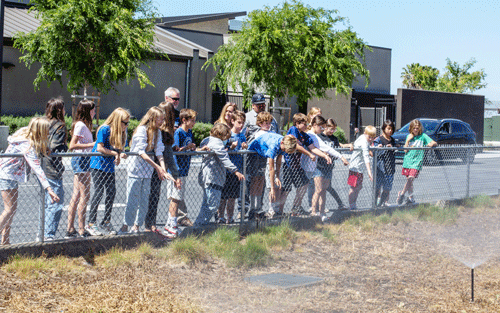Stormwater Capture and Use Short Program
It is estimated that billions of gallons of water have been rushing into the ocean during heavy rain events. At the same time reservoirs that capture, and store water are at historic lows. What can schools and individuals do to capture stormwater runoff and use it at their school and at their homes?
In this series of six one-hour meetings, students use research tools to explore their school site and design strategies for stormwater capture and reuse.
Explore school site
Students will explore their school site and identify the infrastructure designed to manage storm event runoff. This will include roofs, gutters and drainpipes, school site watershed flows and collection areas. This information will be added to a school site topographic base map, with an accurate scale for measuring surface areas.
Study Capture Systems
Roofs provide an opportunity for collecting relatively clean water. Students we learn about the equipment and how to design a system to capture and store water from roofs. Using their school maps, they will calculate the volume of water being generated on a school site roof. Students will then identify structural equipment needed to deliver the roof water into a storage tank.
Students will learn about retention basins and or rain gardens. They will identify ground areas on campus that collect water and then design a project that can utilize the rain event water for landscape needs.
Design and model solutions
Using their school maps, they will calculate the volume of water being generated on a school site. Students will then research the structural equipment needed to deliver the into collection areas (rain tanks and or retention basins). Using design software students will create a 3d model of their project.
Develop strategies and messaging
With a project designed, students will prepare cost estimates for the project along with a project description that includes the benefits achieved. In addition, a verbal presentation with slides will be created.
Present recommendations
Working with Poseidon Education, a VIP panel will be formed (including school administration, local water agencies and municipalities) that will listen to the presentation and provide responses. The final work will be submitted to the school district for consideration.
In this series of six one-hour meetings, students use research tools to explore their school site and design strategies for stormwater capture and reuse.
Explore school site
Students will explore their school site and identify the infrastructure designed to manage storm event runoff. This will include roofs, gutters and drainpipes, school site watershed flows and collection areas. This information will be added to a school site topographic base map, with an accurate scale for measuring surface areas.
Study Capture Systems
Roofs provide an opportunity for collecting relatively clean water. Students we learn about the equipment and how to design a system to capture and store water from roofs. Using their school maps, they will calculate the volume of water being generated on a school site roof. Students will then identify structural equipment needed to deliver the roof water into a storage tank.
Students will learn about retention basins and or rain gardens. They will identify ground areas on campus that collect water and then design a project that can utilize the rain event water for landscape needs.
Design and model solutions
Using their school maps, they will calculate the volume of water being generated on a school site. Students will then research the structural equipment needed to deliver the into collection areas (rain tanks and or retention basins). Using design software students will create a 3d model of their project.
Develop strategies and messaging
With a project designed, students will prepare cost estimates for the project along with a project description that includes the benefits achieved. In addition, a verbal presentation with slides will be created.
Present recommendations
Working with Poseidon Education, a VIP panel will be formed (including school administration, local water agencies and municipalities) that will listen to the presentation and provide responses. The final work will be submitted to the school district for consideration.
Benefits to educators and students
|
Features of all of our programs
|


